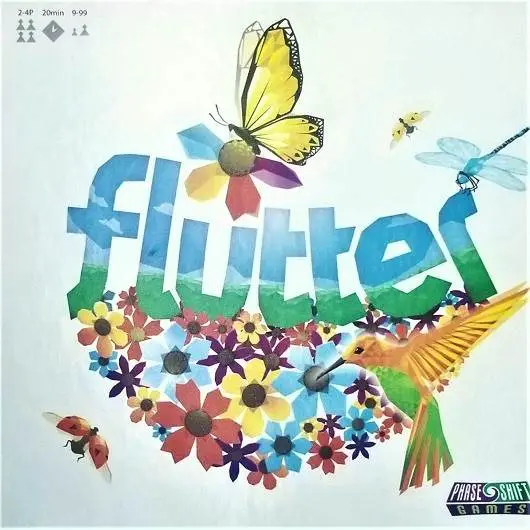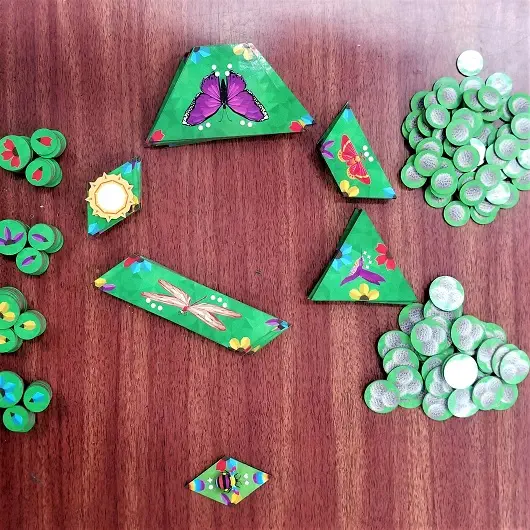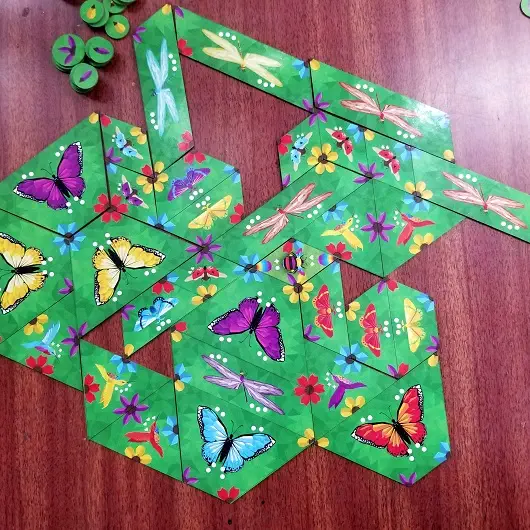Anyone else remember playing with tangrams as a child? The polygon puzzle pieces that can be turned or flipped to fit just the right way to form specific shapes? They were some of our favorite toys as children and the nostalgia factor present in Flutter makes it all the more enticing! Let’s be honest, it isn’t too often that we come across a game inspired by the toys of our childhood that are done as well as Flutter. The game isn’t your typical tangram experience, however! As our title suggests, this pollinator-filled puzzle from Phase Shift Games for 2-5 players, ages 8 and up comes with a twist!
At the time of this review, Phase Shift Games is running a crowdfunding campaign on Kickstarter. For this preview, we were sent a prototype copy to try out. Therefore, we highly recommend heading over to their campaign to see better representations of the final product. Art, iconography, and components are all subject to change, so please keep in mind we won’t go too deep into these elements as they are better discussed via the campaign page. It should also be noted that there is an FSC-compliant (Forest Stewardship Council) sustainable wooden version available as part of the campaign for those that are interested in a more durable, long-lasting copy.
Flutter was designed by Matt Bahntge and features art from Steven Tu. The setup is pretty quick for this one. Each of the polygon tiles should be separated by type, shuffled, and then placed in a circle. The order is not too important, but it should be clear what order they are meant to be rotated in. Depending on player count, a set number of tiles are removed from each stack. The Sun marker should be put on top of the diamond-shaped tiles. Next, each player should choose a Bee color and take the two tokens of that color. The Petal and Pollen tokens are then placed into their respective piles. Finally, the “Rainbee” is placed on the table as the first tile. It is important to make sure that there is a large play space when playing Flutter. While the game may look small and compact, the play area grows quite a bit as the “Meadow” expands.
The rules for Flutter are straightforward, though their implementation allows for creativity and strategy beyond what might first be apparent. There is a layer of strategy that unfolds as the game progresses and can catch a player off guard if unprepared. On your turn, players will select the next tile after the sun marker (or pay petals to skip tiles) and place it against at least one other tile already in play. Any flowers that line up will grant petals for matching colors. However, if any given flower has no matching petals, the player must instead pay petals from their stash in order to place the tile at that location. If a player cannot pay the cost, they must choose somewhere else to set their tile. While this seems easy enough, there were plenty of times we grumbled at not having the resources to play where we wanted to. If a player manages to completely cut off a tile already in play from the outside of the Meadow, they will also need to have enough petals of that tile’s occupant’s color and indicated quantity to pay as well. Paying this second toll will grant an equal number of pollen tokens in return. At the end of a player’s turn, they have the option to place their Bee on an unenclosed tile. Should that tile be enclosed, the owner of the Bee earns two pollen regardless of who enclosed it. The Sun marker gets moved to the top of the most recently used pile and play continues until one pile runs out of pieces. When this happens, all other players will get one last turn. At the very end, Pollen is counted to determine the winner of the game.
There is no denying that Flutter is a visually appealing game. The tactile, tactical experience is unlike anything we have ever played! However, we have a difficult time defining Flutter as a game. It truly feels more like a puzzle as you try to find where the next piece will go and what the best play might be. This level of strategy also means the game sometimes takes longer than 20 minutes. Additionally, it isn’t a game we would buy just to hand off to the kids. Though a wonderful game to play as a family, Flutter needs an attention to detail that some younger gamers simply may not have developed yet. This by no means makes Flutter any less of a wonderful game. It just means that some adult supervision/assistance is most likely needed. Much like with tangrams, there are a lot of benefits to playing Flutter with younger gamers. Learning shapes, problem-solving, visual-spatial skills, and even color-matching practice are all possible with Flutter. Furthermore, Phase Shift Games has partnered up with Save Our Monarchs as a way to support real-life pollinators! For every purchase of the game, a $1 donation will be given to the Save Our Monarchs Foundation. This is absolutely wonderful and means a lot to us! We’ve all heard about how bad off we would be if bees disappeared, but they are not the only contributors and it’s encouraging to see others in our community putting effort towards saving our fragile ecosystems. Thank you Phase Shift Games!
All photos for this article were taken and edited by Krista. Links updated 4/9/2021


